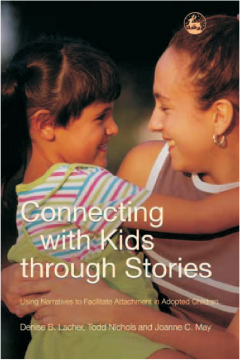
Additional Information
Book Details
Abstract
Children whose early development has been damaged by abuse or neglect are notoriously difficult to reach. Through many years' therapeutic work with adopted children and their families, the Family Attachment Center of Minnesota has developed an exciting and innovative technique which uses stories as the main mode for helping parents to communicate and connect with their troubled children. Connecting with Kids through Stories is an accessible guide to Family Attachment Narrative Therapy for the parents of adopted or fostered children, and for the professionals who work with them.rnrnProviding a thorough theoretical grounding, and detailed information on therapeutic techniques and how to assess progress, the book shows parents how to create their own therapeutic stories to promote increased attachment and improved behavior in their child. The authors describe how different kinds of narratives can help with specific difficulties and illustrate their techniques with the story of a fictional family who develop their own narratives to help their adopted child heal.rnrnThe Family Attachment and Counseling Center of Minnesota works to promote the growth and healthy functioning of individuals and families through professional guidance, with a particular emphasis on services for children. The Center's Family Attachment Narrative Therapy program has been especially developed to help children whose development has been compromised by early life trauma and attachment relationship difficulties.
Table of Contents
| Section Title | Page | Action | Price |
|---|---|---|---|
| Figures, tables, and boxes | |||
| About the editors | |||
| Acronyms and abbreviations | |||
| Acknowledgements | |||
| Foreword | |||
| Robert Chambers | |||
| 1. Going beyond open defecation free | |||
| Naomi Vernon and Petra Bongartz | |||
| Mapping the territory | |||
| 2. Sanitation in Bangladesh: revolution, evolution, and new challenges | |||
| Suzanne Hanchett | |||
| 3. Building environments to support sustainability of improved sanitation behaviours at scale: levers of change in East Asia | |||
| Nilanjana Mukherjee | |||
| 4. Strengthening post-ODF programming: reviewing lessons from sub-Saharan Africa | |||
| Ann Thomas | |||
| Physical sustainability | |||
| 5. CLTS and sanitation marketing: aspects to consider for a better integrated approach | |||
| Twitty Munkhondia, Warren Mukelabai Simangolwa and Alfonso Zapico Maceda | |||
| 6. User-centred latrine guidelines – integrating CLTS with sanitation marketing: a case study from Kenya to promote informed choice | |||
| Yolande Coombes | |||
| 7. Sanitation infrastructure sustainability challenges case study: Ethiopia | |||
| Hunachew Beyene | |||
| 8. The long-term safe management of rural shit | |||
| Jamie Myers | |||
| Post-ODF engagement and monitoring | |||
| 9. Beyond ODF: a phased approach to rural sanitation development | |||
| Andrew Robinson and Michael Gnilo | |||
| 10. Roles and responsibilities for post-ODF engagement: building an enabling institutional environment for CLTS sustainability | |||
| Samuel Musembi Musyoki | |||
| 11. Who is managing the post-ODF process in the community? A case study of Nambale sub-county in Western Kenya | |||
| Elizabeth Wamera | |||
| 12. Tools for embedding post-ODF sustainability: experiences from SNV Nepal | |||
| Anup Kumar Regmi | |||
| 13. Certification of open defecation-free status: emerging lessons from Kenya | |||
| Lewnida Sara | |||
| How to ensure equity and inclusion | |||
| 14. Promoting choice: smart finance for rural sanitation development | |||
| Andrew Robinson and Michael Gnilo | |||
| 15. Putting the hardest to reach at the heart of the Sustainable Development Goals | |||
| Sue Cavill, Sharon Roose, Cathy Stephen and Jane Wilbur | |||
| 16. Leave no one behind: equality and non-discrimination in sanitation and hygiene | |||
| Archana Patkar | |||
| How to transform social norms | |||
| 17. Purity, pollution, and untouchability: challenges affecting the adoption, use, and sustainability of sanitation programmes in rural India | |||
| Aashish Gupta, Diane Coffey, and Dean Spears | |||
| 18. Using social norms theory to strengthen CATS impact and sustainability | |||
| Therese Dooley, Louise Maule and Michael Gnilo | |||
| 19. Conclusion: gaps in knowledge and further research needed | |||
| Naomi Vernon and Petra Bongartz |
